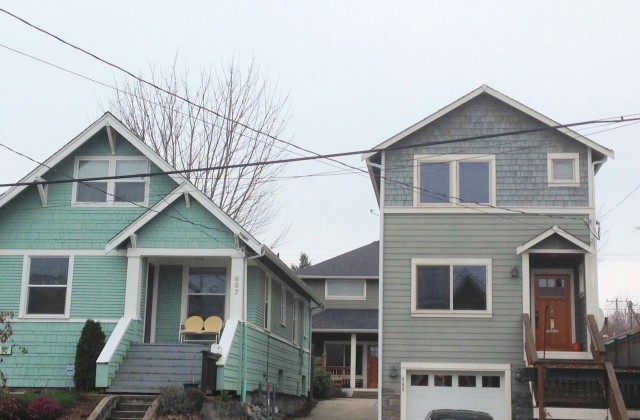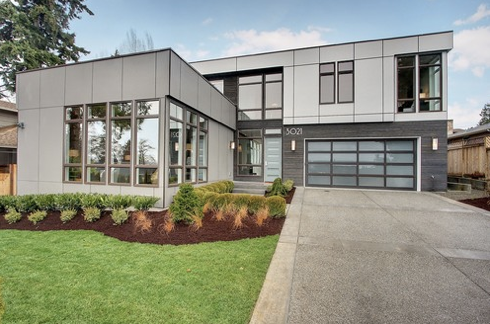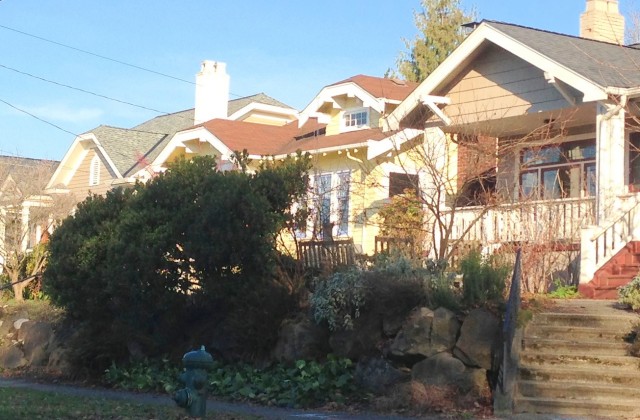Other Blogs: Two Posts on Housing and Development
Over the last week or so I have written two posts at other blogs, Publicola and Seattle Transit Blog. At Publicola I wrote, “New Single Family Housing is Not the Enemy” to take on the notion that single-family infill development is somehow a threat to neighborhood character. At Seattle Transit Blog I took on the caricature of the “greedy developer” by pointing out the complexity of development projects of any size. These two posts were intended to tackle a deep and broad reservoir of suspicion about development in general and infill development in specific.
Part of the mission of Smart Growth Seattle is addressing these issues directly. We’re doing that by:
- Engaging the process—Our initiative on finalizing small-lot legislation is a compromise, accepting new limits and rules on building new homes in single-family zones.
- Create some predictability—We believe in good, well thought out rules for new housing in single-family neighborhoods because they create predictability for builders and for neighborhoods. Everyone needs to know what to expect when new homes are proposed.
- Expand choices—The goal of our work at Smart Growth Seattle is about expanding housing choice and opportunity as Seattle grows.
The response to our efforts has been positive and we’ll keep the efforts up in the weeks and months ahead as the Seattle City Council considers ideas for legislation. As always, we appreciate your comments here or anyplace these topics get discussed.
A Building Boom: Small Homes Are Big in Vancouver B.C.
Canadian media has been abuzz in the last year over the proliferation of small houses in Vancouver, British Columbia’s single-family neighborhoods. But the story there has been about the innovation, sustainability, affordability, and predictability of the new homes, not about controversy about their impact on neighborhood character. In fact, in environment is so supportive that since 2009 when laneway housing (Vancouver’s term for cottage housing) was approved over 500 of them have been built in Vancouver. According to the Department of Planning and Development’s website, that’s about the same number of single-family homes and Detached Accessory Dwelling Units (DADUs) have been built in Seattle combined. Vancouver, a city know for it’s density and tall buildings, is also growing strongly in it’s single-family neighborhoods.
Here’s the stats from a report from Vancouver’s CTV News:
The City of Vancouver has received 500 permit applications to build new laneway homes. Since the 2009 launch of Vancouver’s EcoDensity laneway housing initiative, hundreds of small homes have been built or are nearing completion. The permit department handles up to 50 new applications each month.
One of the big advantages of laneway housing in Vancouver is that the standards for how it has to be built and how the homes have to comply with zoning and building codes. One company, Smallworks, has developed a (pun alert!) cottage industry in building laneway houses that range from 500 to 2000 square feet. Far from being something that has limited interest in these houses, consistent and predictable standards for new housing in single-family have made them affordable and accessible.
Vancouver’s success in encouraging this form of housing doesn’t have anything to do with any specific formula for lot coverage like Floor Area Ratio, but rather the openness of the city to encourage infill development as a sustainability strategy.
From a recent article in the Vancouver Sun:
Livability and sustainability — not to mention affordability — are key words in the Vancouver region right now as cities struggle to balance a need to accommodate an estimated one million more residents over the next 25 years with a desire to preserve green space and limit urban sprawl.
That discussion has encouraged a range of new housing options to spring up in recent years in what had been predominantly single-family home neighbourhoods from the west side of Vancouver out to the Fraser Valley. Those options range from chic highrise towers and condominiums to the introduction of laneway and coach houses ranging in size from about 600 to 1,200 square feet.
It’s all about options, and Vancouver has opened more of them by encouraging more small houses to fill in empty spaces in single-family neighborhoods. The ease with which these are permitted means many of them use prefabricated components and can be built very quickly. This reduces expenses making the homes more affordable. And it certainly helps prices that there are more of them being made.
But there is another factor: people like the idea of having their own detached home, even if it is small. Increasing density and lowering price means more closeness too. One couple featured in a story about laneway housing said it this way:
It’s really a North American concept to have success tied to moving away or distancing yourself, so maybe we’re reinventing what it means to be successful, and that means keeping family close.
Vancouver’s enthusiasm for small homes as part of an effort to expand housing supply and choice should be a lesson to Seattle in the year ahead. Not only can we expand housing choice by finalizing small lot legislation, but by making some consistent and predicable rules we can make it more affordable and accessible too.
Video from Smallworks website.
Is New Housing Conniving, Rude and Rapacious?
Yesterday in Crosscut Mark HInshaw posted what could only be called an emotional outburst about new development in Seattle. His point seemed to be that new development is hurting Seattle’s sense of community. New housing, especially in single-family neighborhoods is too big and ugly and we shouldn’t build any more of it unless it’s tiny cottages that won’t produce a return on investment for private developers. Let’s look at some basic facts that Hinshaw ignores.
- Smaller houses—most new single-family home construction is of modest scale. Occasionally large houses do get built in the city, but that’s the exception not the rule. Take a look at the Blueprint Capital website and you’ll see lots of two story houses that fit quite well into their context.
- Housing opportunity—Seattle City Councilmember Richard Conlin said it well when he said that we need more housing in Seattle’s single-family neighborhoods because families need as many housing opportunities as possible. Building smaller homes in single-family neighborhoods increases choices and options for families moving to Seattle.
- Growth management—Hinshaw seems to want to force the issue: require so many limits to new housing that anyone trying to “build a house on a remnant lot that is, say 1,000 square feet, would be stuck with building a tiny, cottage-like dwelling. For most rapacious people, the trouble would hardly be worth it. And even if they managed to make it work financially, the impact on neighbors would be pretty minimal.” That means new people moving into Seattle who want a single-family home would have a choice between Hinshaws impossibly small cottage or a real house in the suburbs. Hinshaw’s limits would make it more likely that those families wouldn’t be living in Seattle but outside the city which undermines the principles of growth management.
- Building is a business—building is a business and Hinshaw seems to think that builders, developers, and architechts make too much money doing infill development. That’s a strange sentiment considering that often developers lose money on projects; nothing is certain in the world of development. Hinshaw seems peeved that people who take risks end up making money back in excess of what they spent to build the project. It’s hard to see what the alternative would be; publicly funded single-family home construction? Or, as is probably the case, Hinshaw probably doesn’t want any new single-family home construction.
Smart Growth Seattle is committed to going forward, supporting predictability for single-family development through good rules and planning. The City seems committed to encouraging development in single-family neighborhoods because it makes sense, is consistent with the Comprehensive Plan, and it creates jobs. We also think that we should unfurl the welcome mat for people interested in living in Seattle. That’s the way to build community, while Hinshaw seems to characterize new people moving into the city as “double-income earning couple[s] with a penchant for conspicuous consumption.”
Hinshaw, also, has a pretty negative view of the people who build housing in Seattle:
We have had a history of people in the development sector who look for ways to misuse or stretch well-intended regulations for their own financial gain. And what that does is paint everyone else doing development as conniving, rude and rapacious.
It seems doubtful that increasing housing choice, creating jobs, and supporting the principles of growth management fits anyone’s definition of “conniving, rude, and rapacious.”
Photo of new single-family development from Blueprint Capital
Preventing Sprawl and Preserving Neighborhood Character
Along with highlighting Seattle City Councilmember Richard Conlin’s support of more housing in single-family neighborhoods, this week’s Seattle Times story on neighborhood density had some confusing language about growth and growth targets. I think it’s worth looking at the Growth Management Act (GMA), growth targets, the City’s Comprehensive Plan, and what growth in single-family neighborhoods should look like. Seattle will continue to grow, including in single-family neighborhoods. Most growth will occur in multifamily neighborhoods, but more single-family homes will get built in single-family zones. The importance of building new homes in single-family zones isn’t because those homes will absorb lots of growth, but that these new homes provide a wider variety of housing choices in the city, rather than in sprawling suburbs.
The GMA was passed more than 20 years ago to prevent sprawl, a land use pattern emphasizing low density housing development linked by lots of roads and highways. By planning for future population and job growth in dense urban centers, the GMA intended to prevent more environmental degradation, traffic congestion, and highway construction associated with sprawl.
Under the GMA, counties and cities develop comprehensive plans for how growth will be managed within their jurisdictions, including land use policies and infrastructure investments. Part of the planning process is the “growth target,” an estimation of the number of people, housing units, and jobs local jurisdictions might expect. Here’s a description of growth targets from the Office of Financial Management:
Development of population projections for the Growth Management Act (GMA) is a shared responsibility. As directed by state statute, OFM prepares a reasonable range of possible population growth for Washington counties participating in GMA. County officials, also by law, are responsible for selecting a 20-year GMA planning target from within the range of high and low prepared by OFM. County officials select the county planning target; then within each county, population planning targets for cities, towns, and unincorporated areas are developed among all affected local jurisdictions as part of the city and county planning process.
Growth targets are not mandates for cities from the state. Neighborhood advocates and others who are opposing projects or growth in general will often site growth targets as the basis for saying that a neighborhood has “taken” enough growth. As I pointed out in the Seattle Times article and elsewhere, growth targets don’t work that way.
Growth targets are a floor not a ceiling; the number of people, jobs, and housing can and should exceed the target. There are no sanctions for exceeding growth projections. This confusion about how to use population projections for planning has been made worse when policy makers attach requirements or regulatory relief to growth targets. This results, for example, in regulatory reforms that reduce costs for new development only in areas that are below growth projections, while places that are growing more quickly don’t benefit.
Thompson’s story makes it seem like growth in single-family neighborhoods is somehow connected to growth targets when it isn’t. The Comprehensive Plan doesn’t establish a limit on growth, only a plan for how it should happen, and most of that plan and the targets apply to Urban Villages not to single-family neighborhoods. Seattle’s Comprehensive Plan is pretty clear about growth in single-family neighborhoods:
The strategy of focusing future development in urban villages continues to direct new development away from Seattle’s single-family areas. (Urban Village Element 1.4)
Does that mean no single-family houses, Detached Accessory Dwelling Units, or cottages can or should be built in Seattle? Hardly. Here’s more on single-family growth from the Comprehensive Plan:
Maintain and enhance Seattle’s character as the city grows and changes. Seattle’s character includes its built environment: large areas of detached single-family houses both inside and outside of urban villages, many thriving multifamily areas, mixed-use commercial areas, industrial areas, major institutions, and a densely developed downtown with surrounding high-density neighborhoods. (Urban Village Element G1)
Enhance by every definition of the word, means a qualitative and quantitative increase (i.e. more and better). Enhancing single-family neighborhoods requires building new and different kinds of housing in those zones. And preserve should hardly be taken in this context to mean “no change whatsoever.”
There’s more.
Preserve and protect low-density, single- family neighborhoods that provide opportunities for home-ownership, that are attractive to households with children and other residents, that provide residents with privacy and open spaces immediately accessible to residents, and where the amount of impervious surface can be limited. (Land Use Element G8)
Take note that the first sentence of this section doesn’t say “preserve and protect low-density, single-family houses,” or views, or comfort of residents but, “neighborhoods.” There is nothing static about preserving and protecting single-family neighborhoods. In fact, the best way to do that is to add more single-family residents in new housing in a predictable way. And low-density is a comparative term here, not a set ratio (I think we need to propose a change here to make the word “lower.”)
Here’s more.
Preserve the character of single-family residential areas and discourage the demolition of single-family residences and displacement of residents, in a way that encourages rehabilitation and provides housing opportunities throughout the city. The character of single-family areas includes use, development, and density characteristics. (Land Use element G9)
This section is almost a restatement of the goal of Smart Growth Seattle.
We collaborate with homebuilders and community stakeholders to help government adopt codes that are appropriate for meeting housing demand and preserving neighborhood character.
The whole point of developing new single-family housing is to preserve the existing character by building a similar housing type, not demolishing existing homes (nothing is being demolished in the West Seattle project but a garage!), and creating more housing opportunity and choice.
Councilmember Conlin has already said he wants to see more opportunities and more choices in single-family neighborhoods. That’s good news; it’s also consistent with the comprehensive plan. Some growth will happen in single-family neighborhoods but it won’t be the major quantitative component of meeting or exceeding growth projections. Instead, growth and new homes in single-family neighborhoods will enhance the quality and character of those neighborhoods and the whole city. It also gives people an opportunity to live here rather than in a far off suburb.
Photo of housing in Pasco by author
Richard Conlin: “More opportunities for people who want to live in the city.”
There is a lot to think about and respond to in Lynn Thompson’s recent story about neighborhood density in the Seattle Times. The story seems to confound growth targets with growth in single-family neighborhoods (more on this later). Growth targets mostly apply to Urban Villages, those knots of more intense activity and use like the business districts of Wallingford or Columbia City. But growth is going to happen in our single-family neighborhoods too since may people want to live in detached homes. We’re not going to achieve our growth goals in single-family neighborhoods, but we will provide more choices for families who want to live in the city.
That’s why when we set aside all the breathlessness hyperbole about building more homes in single-family neighborhoods (It’s like a shark attack!), what we’re really talking about is increasing choices for people moving to Seattle. And the good news is that the Chair of the City Council’s Planning and Land Use and Sustainability Committee agrees:
City Councilmember Richard Conlin, chair of the Planning, Land Use and Sustainability Committee, said infill development in single-family neighborhoods “provides more opportunities for people who want to live in the city.”
There it is in black and white in the Seattle Times. Councilmember Conlin gets the message. We are going to continue to grow in Seattle and some of that growth will be in single-family neighborhoods. The question is really about how that happens, not if it happens. It is encouraging that Conlin understands this point. People want to live in our city and they should have a wide choice of housing opportunity in all parts of our city.
Photo of Wallingford single-family by author, shark video by Steven Spielberg.





